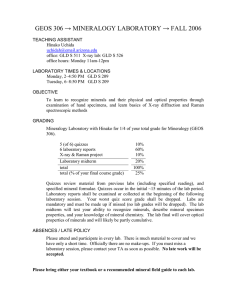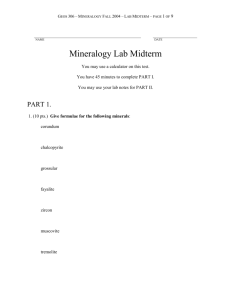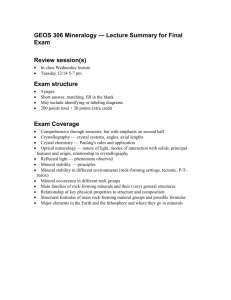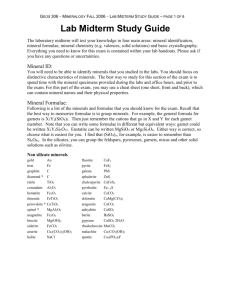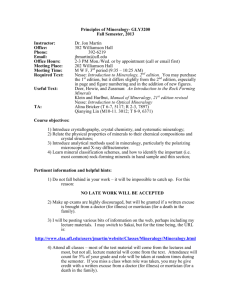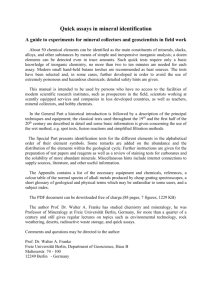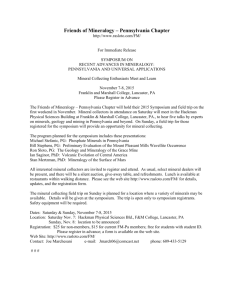Mineralogy Lab Midterm
advertisement
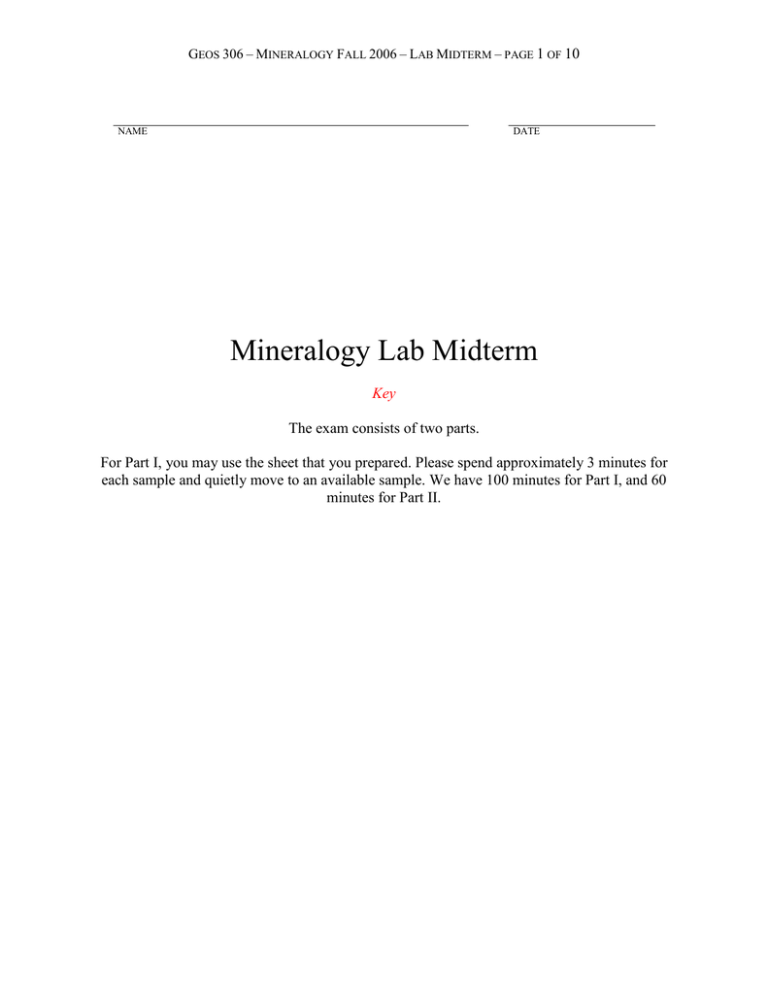
GEOS 306 – MINERALOGY FALL 2006 – LAB MIDTERM – PAGE 1 OF 10 NAME DATE Mineralogy Lab Midterm Key The exam consists of two parts. For Part I, you may use the sheet that you prepared. Please spend approximately 3 minutes for each sample and quietly move to an available sample. We have 100 minutes for Part I, and 60 minutes for Part II. GEOS 306 – MINERALOGY FALL 2006 – LAB MIDTERM – PAGE 2 OF 10 PART I. MINERAL IDENTIFICATION (40 pts) There are twenty minerals to identify, one mineral per station. You will be given three minutes to examine a sample, then you must move to the next sample. After everyone has viewed all of the samples, you may return to any samples that you may wish to re-examine. You may use your sheet that contains minerals and properties. You may also use streak plates, hardness kits, and magnets to identify these minerals. For each sample, fill in the distinctive properties you observe in the table below. The distinctive properties include color, luster, habit, cleavage, hardness, heft, etc., or combinations of these (Do not list all these properties but please list only the characteristic properties that are keys to identification of each mineral). You will receive full credit (2 points) for each properly identified mineral, in which case the grader shall ignore the distinctive properties. For unidentified and improperly identified minerals, correctly listing distinctive properties may earn up to 1 point of partial credit. Misspelled mineral names result in 1 point penalties. SAMPLE IDENTITY 1 kyanite 2 plagioclase 3 siderite 4 staurolite 5 garnet 6 molybdenite 7 pyrite 8 azurite DISTINCTIVE PROPERTIES GEOS 306 – MINERALOGY FALL 2006 – LAB MIDTERM – PAGE 3 OF 10 9 gypsum 10 corundum 11 tourmaline 12 andalusite 13 microcline 14 serpentine 15 muscovite 16 barite 17 apatite 18 fluorite 19 vanadinite 20 aragonite bonus vesuvianite GEOS 306 – MINERALOGY FALL 2006 – LAB MIDTERM – PAGE 4 OF 10 PART II. 6. (8 pts.) For each of the following, (1) solve for the cation valence, (2) suggest a likely cation for the structure, and (3) name the mineral. Valence R?3Al2(SiO4)3 2+ Likely cation Mineral Name Mg, Mn, Ca, or Fe pyrope ,spessartine,grossular,almandine KR?3(Si3Al)O10(OH)2 2+ Fe or Mg R?Ca(CO3)2 2+ Mg R?AlSi2O6 1+ Li or Na biotita or phlogopite dolomite spodumene or jadeite GEOS 306 – MINERALOGY FALL 2006 – LAB MIDTERM – PAGE 5 OF 10 7. (10 pts.) Symmetry (a) Draw the unit cell of a hexagonal crystal. Please label the axes (a, b, c) and angles (α, β, γ ). Also, describe the relations of a, b, c and α, β, γ. Look at page 43 of Wenk and Bulakh (b) What are the crystal systems of the models? List all the rotational symmetry axes that you see for each model. 1. 2. 3. 4. (3x) 2-fold axes: orthorhombic (1x) 2-fold axes: monoclinic only 1-fold axis (identity): triclinic (1x) 3-fold axis and 2-fold axes: hexagonal GEOS 306 – MINERALOGY FALL 2006 – LAB MIDTERM – PAGE 6 OF 10 7. (4 pts.) Silicate Structures Look at Page 2 of your Lab 4 (Introduction to Silicates).
